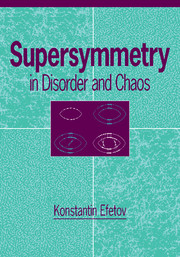Book contents
- Frontmatter
- Contents
- Preface
- Acknowledgments
- 1 Introduction
- 2 Supermathematics
- 3 Diffusion modes
- 4 Nonlinear supermatrix σ-model
- 5 Perturbation theory and renormalization group
- 6 Energy level statistics
- 7 Quantum size effects in small metal particles
- 8 Persistent currents in mesoscopic rings
- 9 Transport through mesoscopic devices
- 10 Universal parametric correlations
- 11 Localization in systems with one-dimensional geometry
- 12 Anderson metal–insulator transition
- 13 Disorder in two dimensions
- 14 Afterword
- Appendix 1 Calculation of the Jacobian
- Appendix 2 Magnetic field parametrization
- Appendix 3 Density–density correlation function at k = 0
- Appendix 4 Effective medium approximation as a saddle point
- References
- Author index
- Subject index
10 - Universal parametric correlations
Published online by Cambridge University Press: 10 November 2010
- Frontmatter
- Contents
- Preface
- Acknowledgments
- 1 Introduction
- 2 Supermathematics
- 3 Diffusion modes
- 4 Nonlinear supermatrix σ-model
- 5 Perturbation theory and renormalization group
- 6 Energy level statistics
- 7 Quantum size effects in small metal particles
- 8 Persistent currents in mesoscopic rings
- 9 Transport through mesoscopic devices
- 10 Universal parametric correlations
- 11 Localization in systems with one-dimensional geometry
- 12 Anderson metal–insulator transition
- 13 Disorder in two dimensions
- 14 Afterword
- Appendix 1 Calculation of the Jacobian
- Appendix 2 Magnetic field parametrization
- Appendix 3 Density–density correlation function at k = 0
- Appendix 4 Effective medium approximation as a saddle point
- References
- Author index
- Subject index
Summary
Brownian motion model
Fokker–Planck equation for the Coulomb gas model
In the preceding chapters the relation between random matrix theory and the zero-dimensional supersymmetric σ-model was emphasized many times. This equivalence makes it possible to use the σ-model for a description of such nontrivial problems as transport through quantum dots in the regime of chaotic dynamics. By changing external parameters such as magnetic field or gate voltage one can study correlations of physical quantities at different values of these parameters. One example has been considered in Section 9.4. One can also study the dependence of average quantities on the external parameters, and the persistent currents considered in Chapter 8 are this type of problem. In many cases the final formulae are quite universal, depending only on the mean level spacing and several parameters characterizing changes in the initial Hamikonian.
It is clear now that study of parametric correlations leads to new and very interesting and unexpected results. Again, much important work has been performed in the last 1–2 years, and therefore the content of this chapter reflects only the present state of the art.
I want to present first what was known about parametric correlations in random matrix theory in the past. The most important work in this area is that of Dyson (1962b), who proposed to use the idea of Brownian motion, well known in kinetic theory (Chandrasekhar ((1943), Uhlenbeck and Ornstein (1930), Wang and Uhlenbeck (1945), Isihara (1971)), to describe parametric variations of physical quantities.
- Type
- Chapter
- Information
- Supersymmetry in Disorder and Chaos , pp. 246 - 273Publisher: Cambridge University PressPrint publication year: 1996

